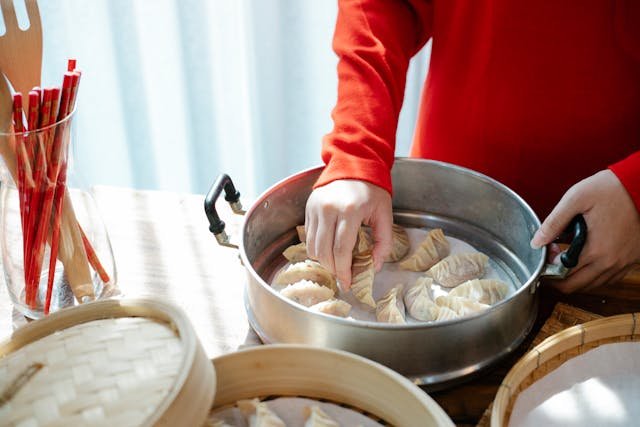The Winter Solstice, known as Dongzhi Festival (冬至节, Dōngzhì Jié) in China, is a deeply rooted and ancient celebration marking the shortest day and longest night of the year. Typically falling around December 21 or 22, this festival occurs when the Earth’s axial tilt is farthest from the Sun in the Northern Hemisphere. The significance of Dongzhi lies not only in its astronomical implications but also in its rich cultural and historical context.
Table of Contents
ToggleHistorical and Cultural Significance
Dongzhi, which translates to “the extreme of winter” (冬至, dōngzhì), has its roots in the philosophy of yin and yang (阴阳, yīnyáng), representing balance and harmony in life. This balance is crucial in Chinese thought, reflecting the interplay between opposing forces. The festival originated during the Han Dynasty (汉朝, Hàn Cháo) (202 BC–220 AD), a period that laid much of the foundation for Chinese cultural practices. It was traditionally an occasion for families to gather and celebrate the increase of positive energy (阳气, yángqì) with the return of longer daylight hours. The Winter Solstice marks a turning point, symbolizing the gradual rise of positive energy and the return of light, which is a critical aspect of agricultural societies that depend on sunlight for their crops.
As the saying goes, “一阳复始,万象更新” (yī yáng fù shǐ, wàn xiàng gēng xīn) – “With the return of the yang, everything takes on a new look.”
Customs and Traditions
The customs of Dongzhi vary between northern and southern China, reflecting the country’s diverse cultural landscape. This diversity is highlighted by different regional practices and culinary traditions.
In Southern China: Eating Tangyuan (汤圆, tāngyuán)
In southern China, families come together to make and eat tangyuan (汤圆, tāngyuán), glutinous rice balls that can be either sweet or savory. These rice balls are typically filled with sweet sesame paste (芝麻酱, zhīmájiàng), red bean paste (红豆沙, hóngdòushā), or peanuts (花生, huāshēng), and are served in a light syrup or broth. The round shape of tangyuan symbolizes reunion and unity (团圆, tuányuán). The process of making tangyuan is often a family affair, where each member participates in rolling the dough and forming the balls, fostering a sense of togetherness. Eating tangyuan during Dongzhi is believed to bring family togetherness and prosperity (繁荣, fánróng) in the coming year. This tradition emphasizes the importance of family unity and the hope for a prosperous future.
Example: During Dongzhi, a mother might say to her children, “吃了汤圆,就长大一岁了” (chī le tāngyuán, jiù zhǎng dà yí suì le) – “After eating tangyuan, you are one year older.”
In Northern China: Eating Dumplings (饺子, jiǎozi)
In northern China, the focus is on eating dumplings (饺子, jiǎozi), particularly those filled with lamb (羊肉, yángròu), pork (猪肉, zhūròu), and vegetables (蔬菜, shūcài). This tradition is linked to a famous legend about Zhang Zhongjing (张仲景, Zhāng Zhòngjǐng), a renowned physician from the Eastern Han Dynasty (东汉, Dōng Hàn). According to the legend, Zhang noticed that many people suffered from frostbite (冻伤, dòngshāng), particularly around their ears, during the harsh winters. He prepared dumplings filled with warming herbs (药草, yàocǎo) and meat to distribute among the poor, believing it would help them fend off the cold. Eating dumplings during Dongzhi is now thought to protect against frostbite and illness (疾病, jíbìng).
A common saying in the north is, “冬至吃饺子,不冻耳朵” (dōngzhì chī jiǎozi, bú dòng ěrduo) – “Eat dumplings on Dongzhi to keep your ears from freezing.”
Modern Celebrations
While the essence of Dongzhi remains deeply rooted in traditional customs, modern celebrations have evolved to include a variety of activities that reflect contemporary life. Many people take this time to visit temples (寺庙, sìmiào), offer prayers (祈祷, qídǎo), and make offerings to their ancestors (祭祖, jìzǔ). This period is one of reflection (反思, fǎnsī) and preparation (准备, zhǔnbèi) for the upcoming new year. Visiting temples and offering prayers is a way for individuals to connect with their spiritual beliefs and seek blessings for the future.
In urban areas, communities often organize public events, including cultural performances (文化表演, wénhuà biǎoyǎn) and cooking competitions (烹饪比赛, pēngrèn bǐsài), to celebrate the festival. These events showcase traditional arts, music, and culinary skills, fostering a sense of community and cultural pride. Schools and educational institutions might hold special classes (特别课程, tèbié kèchéng) or workshops (工作坊, gōngzuòfāng) to teach younger generations about the significance and history of Dongzhi, ensuring that these traditions are passed down (传承, chuánchéng). This educational aspect is crucial for preserving cultural heritage and instilling a sense of identity in the younger generation.
A proverb often quoted during these gatherings is, “前人栽树,后人乘凉” (qián rén zāi shù, hòu rén chéng liáng) – “The older generation plants trees, and the younger generation enjoys the shade,” reflecting the importance of passing traditions down through generations.
The Symbolism of Dongzhi
Dongzhi is more than just a celebration of the winter solstice; it embodies the philosophy of balance and harmony (平衡与和谐, pínghéng yǔ héxié) that is central to Chinese culture. The festival reminds people of the cyclical nature of life (生活的循环性质, shēnghuó de xúnhuán xìngzhì) and the importance of family and community (家庭和社区, jiātíng hé shèqū). As the shortest day of the year gives way to longer days, it symbolizes hope (希望, xīwàng), renewal (重生, chóngshēng), and the positive energy (积极能量, jījí néngliàng) that the longer days bring.
An idiom that captures this sentiment is “冬去春来” (dōng qù chūn lái) – “As winter goes, spring comes,” highlighting the hope and renewal that Dongzhi brings.
In essence, the Dongzhi Festival is a time for reflection, gratitude (感恩, gǎn’ēn), and looking forward to the future with optimism (乐观, lèguān). Whether through the simple act of sharing a meal of tangyuan or dumplings with loved ones or through more elaborate community celebrations, Dongzhi continues to be a cherished tradition that strengthens familial and social bonds (家庭和社会纽带, jiātíng hé shèhuì niǔdài) while honoring the natural rhythms of the Earth.
Conclusion
The Winter Solstice or Dongzhi Festival is a profound reminder of the intricate relationship (复杂关系, fùzá guānxì) between nature and human life (自然和人类生活, zìrán hé rénlèi shēnghuó). As families across China gather to mark this special occasion, the customs and traditions observed during Dongzhi continue to reinforce the values of unity (团结, tuánjié), warmth (温暖, wēnnuǎn), and hope. Whether in the bustling cities (繁忙的城市, fánmáng de chéngshì) or the tranquil countryside (宁静的乡村, níngjìng de xiāngcūn), the spirit of Dongzhi remains a vital part of Chinese cultural heritage (文化遗产, wénhuà yíchǎn), celebrating the enduring harmony (持久的和谐, chíjiǔ de héxié) between humanity and the natural world (人类与自然世界, rénlèi yǔ zìrán shìjiè).
This intricate relationship can be summed up with the idiom, “天人合一” (tiān rén hé yī) – “Unity of heaven and humanity,” reflecting the deep connection between human life and the natural world.
Vocabulary List
- 冬至 (dōngzhì) – Winter Solstice
- 阴阳 (yīnyáng) – Yin and Yang
- 阳气 (yángqì) – Positive Energy
- 团圆 (tuányuán) – Reunion, Unity
- 繁荣 (fánróng) – Prosperity
- 饺子 (jiǎozi) – Dumplings
- 张仲景 (Zhāng Zhòngjǐng) – Zhang Zhongjing
- 冻伤 (dòngshāng) – Frostbite
- 药草 (yàocǎo) – Herbs
- 疾病 (jíbìng) – Illness
- 祈祷 (qídǎo) – Prayers
- 寺庙 (sìmiào) – Temples
- 祭祖 (jìzǔ) – Ancestor Offerings
- 反思 (fǎnsī) – Reflection
- 准备 (zhǔnbèi) – Preparation
- 文化表演 (wénhuà biǎoyǎn) – Cultural Performances
- 烹饪比赛 (pēngrèn bǐsài) – Cooking Competitions
- 特别课程 (tèbié kèchéng) – Special Classes
- 工作坊 (gōngzuòfāng) – Workshops
- 平衡与和谐 (pínghéng yǔ héxié) – Balance and Harmony
- 希望 (xīwàng) – Hope
- 重生 (chóngshēng) – Renewal
- 积极能量 (jījí néngliàng) – Positive Energy
- 感恩 (gǎn’ēn) – Gratitude
- 乐观 (lèguān) – Optimism
- 家庭和社会纽带 (jiātíng hé shèhuì niǔdài) – Familial and Social Bonds
- 复杂关系 (fùzá guānxì) – Intricate Relationship
- 自然和人类生活 (zìrán hé rénlèi shēnghuó) – Nature and Human Life
- 繁忙的城市 (fánmáng de chéngshì) – Bustling Cities
- 宁静的乡村 (níngjìng de xiāngcūn) – Tranquil Countryside
- 文化遗产 (wénhuà yíchǎn) – Cultural Heritage
- 持久的和谐 (chíjiǔ de héxié) – Enduring Harmony
- 人类与自然世界 (rénlèi yǔ zìrán shìjiè) – Humanity and the Natural World
- 一阳复始,万象更新 (yī yáng fù shǐ, wàn xiàng gēng xīn) – With the return of the yang, everything takes on a new look
- 冬至吃饺子,不冻耳朵 (dōngzhì chī jiǎozi, bú dòng ěrduo) – Eat dumplings on Dongzhi to keep your ears from freezing
- 前人栽树,后人乘凉 (qián rén zāi shù, hòu rén chéng liáng) – The older generation plants trees, and the younger generation enjoys the shade
- 冬去春来 (dōng qù chūn lái) – As winter goes, spring comes
- 天人合一 (tiān rén hé yī) – Unity of heaven and humanity








